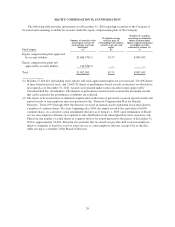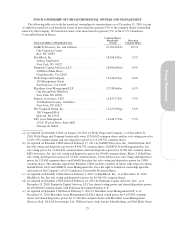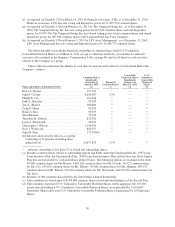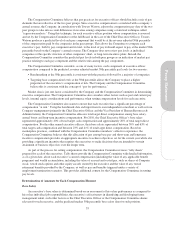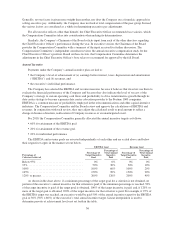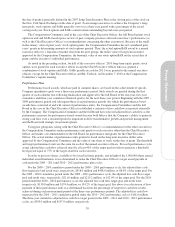Cincinnati Bell 2010 Annual Report Download - page 49
Download and view the complete annual report
Please find page 49 of the 2010 Cincinnati Bell annual report below. You can navigate through the pages in the report by either clicking on the pages listed below, or by using the keyword search tool below to find specific information within the annual report.
The Compensation Committee believes that pay practices for executive officers should include a mix of pay
elements that are reflective of the two peer groups. Since executive compensation is correlated with a company’s
annual revenue, the Company, in consultation with Towers Watson, adjusts the compensation pay data of the two
peer groups to take into account differences in revenue among companies using a statistical technique called
“regression analysis.” Using this technique, for each executive officer position whose compensation is assessed
and set by the Compensation Committee (or the full Board, in the case of the Chief Executive Officer), Towers
Watson produces a predicted level of each pay component that would be at the revenue adjusted 50th percentile
of the compensation paid by the companies in the peer groups. This allows the Committee to compare each
executive’s pay, both by pay component and in total, to the level of pay it should expect to pay at the market 50th
percentile based on the Company’s annual revenue. The Company does not review pay levels at individual
companies or the specific structure of other companies’ short- or long-term incentive plans. Instead, the
Compensation Committee considers the predicted pay levels in both peer groups as an indication of market pay
practice relating to each pay component and the relative mix among the pay components.
The Compensation Committee considers, as one of many factors, each component of executive officer
compensation compared to the predicted, revenue adjusted market 50th percentile pay levels for two reasons:
•Benchmarking at the 50th percentile is consistent with the practice followed by a majority of companies.
•Targeting base compensation levels at the 50th percentile allows the Company to place a higher
proportion of the executive’s compensation at risk. The Company and the Compensation Committee
believe this is consistent with the concept of “pay for performance.”
Market data is just one factor considered by the Company and the Compensation Committee in determining
executive compensation. The Compensation Committee also considers other factors such as past and current pay
levels, internal equity considerations and performance when setting compensation levels for each executive.
The Compensation Committee also wants to ensure that each executive has a significant percentage of
compensation “at risk.” Using the benchmark data and input from its own independent consultant as well as from
Company management (primarily the Chief Executive Officer and the Vice President of Human Resources &
Administration), the Compensation Committee allocates total target direct compensation among base salary,
annual bonus and long-term incentive compensation. For 2010, the Chief Executive Officer’s base salary
represented approximately 40% of total target cash compensation and approximately 20% of total target direct
compensation. For the other named executive officers, their base salary represented between 50% and 63% of
total target cash compensation and between 23% and 41% of total target direct compensation. Based on
marketplace practices, combined with the Compensation Committee members’ collective experience, the
Compensation Committee believes that this allocation of pay among base pay and short-term and long-term
incentive compensation provides an appropriate incentive to achieve objectives set for the current year while also
providing a significant incentive that requires the executives to make decisions that are intended to sustain
attainment of business objectives over the longer term.
As part of the process for setting compensation, the Compensation Committee reviews “tally sheets”
prepared for each of the executives. Tally sheets provide the Compensation Committee with detailed information,
as of a given date, about each executive’s current compensation (including the value of any applicable benefit
programs) and wealth accumulation, including the value of accrued and vested pay, such as shares of Company
stock, vested stock options and other equity awards owned by the executive and the value of any vested
retirement benefits provided by the Company, as well as pay and benefits triggered under a variety of
employment termination scenarios. This provides additional context for the Compensation Committee in setting
pay levels.
Determination of Amounts for Each Compensation Element
Base Salary
An executive’s base salary is determined based on an assessment of his or her performance as compared to
his or her individual job responsibilities, the executive’s effectiveness in identifying and developing future
management talent, such other factors as the Chief Executive Officer or the Compensation Committee deems
relevant for such executive, and the predicted market 50th percentile base salary data for such position.
35
Proxy Statement



